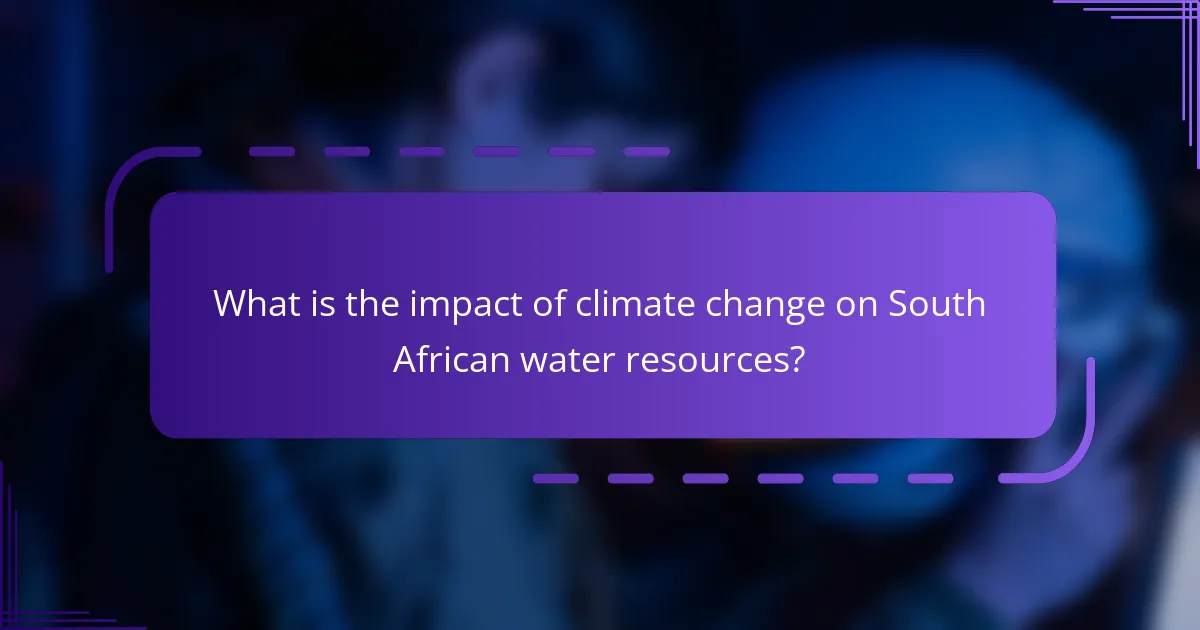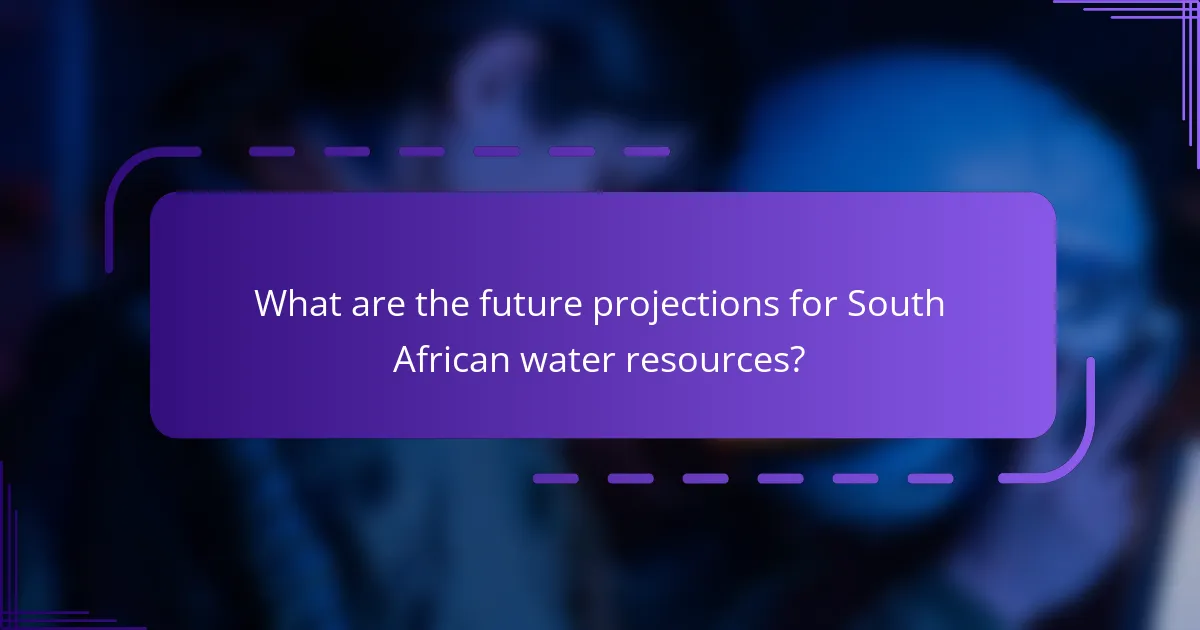Climate change is critically impacting water resources in South Africa, leading to increased temperatures and altered precipitation patterns that result in reduced river flows and groundwater supplies. By 2030, water scarcity may affect up to 14 million people, with extreme weather events like droughts and floods exacerbating water management challenges. The article outlines various adaptation strategies being implemented, including improved water management practices, infrastructure investments, and community-based initiatives aimed at enhancing water resilience. Future projections indicate a potential decrease in rainfall by 10-30% by 2050, highlighting the urgent need for adaptive strategies to ensure sustainable water access in the face of climate change.

What is the impact of climate change on South African water resources?
Climate change significantly impacts South African water resources. It leads to increased temperatures and altered precipitation patterns. These changes result in reduced river flows and dwindling groundwater supplies. According to the South African National Development Plan, water scarcity may affect up to 14 million people by 2030. Extreme weather events, such as droughts and floods, are becoming more frequent. This exacerbates the challenges in water management and distribution. The agricultural sector faces severe risks due to these water shortages. Overall, climate change poses a critical threat to the sustainability of South Africa’s water resources.
How does climate change specifically affect water availability in South Africa?
Climate change significantly reduces water availability in South Africa. Rising temperatures lead to increased evaporation rates. This results in lower water levels in rivers and reservoirs. Changes in rainfall patterns cause prolonged droughts in various regions. For instance, the Western Cape has experienced severe water shortages since 2015. Increased frequency of extreme weather events further disrupts water supply. Climate models predict a decrease in annual rainfall by up to 30% in some areas. These factors collectively threaten agricultural productivity and water security.
What are the key factors contributing to changes in water availability?
Key factors contributing to changes in water availability include climate change, population growth, and land use changes. Climate change leads to altered precipitation patterns and increased evaporation rates. These changes can result in prolonged droughts and reduced water supply. Population growth increases demand for water resources. More people require more water for domestic, agricultural, and industrial use. Land use changes, such as deforestation and urbanization, can disrupt natural water cycles. This disruption affects groundwater recharge and surface water flow. According to the Intergovernmental Panel on Climate Change, these factors collectively threaten water security in regions like South Africa.
How do temperature increases influence water resources?
Temperature increases significantly influence water resources by altering precipitation patterns and increasing evaporation rates. Warmer temperatures lead to more intense and less predictable rainfall events. This can result in both flooding and drought conditions. Increased evaporation reduces surface water levels in lakes and rivers. Furthermore, higher temperatures can degrade water quality by promoting algal blooms. These changes impact agricultural productivity and water supply for communities. According to the Intergovernmental Panel on Climate Change (IPCC), regions like South Africa are particularly vulnerable to these shifts. The increased demand for water in warmer climates exacerbates existing water scarcity issues.
What trends have been observed in South African water resources due to climate change?
Climate change has led to significant trends in South African water resources. Increased temperatures have resulted in higher evaporation rates from water bodies. This has reduced surface water availability across various regions. Altered rainfall patterns have caused both droughts and floods, impacting water supply stability. For instance, the Western Cape has experienced severe droughts, notably from 2015 to 2018. Changes in precipitation have also affected groundwater recharge rates. These trends threaten agricultural productivity and water quality. As a result, water scarcity has become a pressing issue for communities and ecosystems alike.
What historical data shows changes in precipitation patterns?
Historical data indicates significant changes in precipitation patterns in South Africa. Research shows a decline in average annual rainfall by approximately 10% since the 1970s. The Intergovernmental Panel on Climate Change (IPCC) reports increased variability in precipitation, with more intense rainfall events followed by prolonged dry spells. Data from the South African Weather Service reveals regional differences, with the eastern regions experiencing increased rainfall while the western areas face severe droughts. Satellite observations confirm a shift in seasonal rainfall patterns, impacting agricultural productivity and water resources. Historical climate records demonstrate these trends, highlighting the need for adaptive strategies in water resource management.
How have droughts and floods impacted water supply in recent years?
Droughts and floods have significantly impacted water supply in recent years. Drought conditions reduce available surface and groundwater resources. For example, the South African drought from 2015 to 2018 led to severe water shortages in regions like Cape Town. Conversely, floods can overwhelm water management systems, causing contamination and infrastructure damage. In 2021, heavy rainfall in KwaZulu-Natal resulted in flooding that disrupted local water supply and sanitation services. These extreme weather events are becoming more frequent due to climate change, further stressing water resources.

What adaptation strategies are being implemented in South Africa?
South Africa is implementing several adaptation strategies to address climate change impacts. These strategies include improving water management practices. The country is investing in infrastructure to enhance water storage capacity. Rainwater harvesting systems are being promoted to increase local water supply. Additionally, South Africa is developing drought-resistant crop varieties. These crops aim to ensure food security amid changing climate conditions. The government is also fostering community-based adaptation initiatives. These initiatives empower local communities to engage in sustainable practices. Lastly, public awareness campaigns are being conducted to educate citizens about climate resilience.
How are local communities adapting to changes in water resources?
Local communities are adapting to changes in water resources through various strategies. They are implementing rainwater harvesting systems to increase water availability. Many communities are also adopting drought-resistant crops to enhance food security. Education programs are being established to promote water conservation practices. Additionally, local governments are investing in sustainable water management policies. Collaborative efforts among communities are fostering shared water resource management. Some areas are restoring natural ecosystems to improve water retention. These adaptations are crucial as South Africa faces increasing water scarcity due to climate change.
What role do water conservation practices play in adaptation?
Water conservation practices are essential for adaptation to climate change impacts. They help to mitigate water scarcity in regions affected by changing precipitation patterns. Efficient use of water resources can reduce the demand on already stressed water supplies. Implementing techniques like rainwater harvesting and wastewater recycling enhances resilience against droughts. Studies indicate that areas practicing water conservation experience less severe impacts from climate fluctuations. For example, a 2020 report by the South African Water Research Commission highlighted that water-saving measures can improve water availability by up to 30%. This demonstrates the critical role of conservation in ensuring sustainable water management in a changing climate.
How are agricultural practices changing in response to water scarcity?
Agricultural practices are changing to adapt to water scarcity by implementing more efficient irrigation methods. Farmers are increasingly adopting drip irrigation systems that minimize water waste. These systems deliver water directly to plant roots, reducing evaporation and runoff. Additionally, crop selection is shifting towards drought-resistant varieties. These crops require less water and are better suited for arid conditions. Soil moisture management techniques, such as mulching and conservation tillage, are also being utilized. These practices help retain soil moisture and improve water infiltration. According to the South African Department of Agriculture, Forestry and Fisheries, these adaptations are essential for maintaining food security in the face of climate change.
What governmental policies support adaptation to climate change in water management?
Governmental policies that support adaptation to climate change in water management include the National Water Act of 1998. This act promotes sustainable water use and management in South Africa. It emphasizes equitable access to water resources. The Integrated Water Resource Management (IWRM) framework is also crucial. This framework guides the planning and management of water resources in a holistic manner. Additionally, the National Climate Change Adaptation Strategy outlines specific measures for water sector resilience. These measures include enhancing infrastructure and improving water quality. The policies are backed by research indicating the need for adaptive measures due to increased variability in water availability. These frameworks collectively aim to address the challenges posed by climate change on water resources in South Africa.
What are the main objectives of South Africa’s water management policies?
The main objectives of South Africa’s water management policies are to ensure sustainable water use and equitable access to water resources. These policies aim to protect water quality and promote efficient water management practices. They also focus on the conservation of water ecosystems and biodiversity. Additionally, the policies seek to enhance the resilience of water supply systems against climate change impacts. For instance, the National Water Act of 1998 emphasizes the need for integrated water resource management. This approach aims to balance social, economic, and environmental needs regarding water resources.
How is funding allocated for climate adaptation projects?
Funding for climate adaptation projects is allocated through a combination of government budgets, international aid, and private investments. National governments prioritize projects based on vulnerability assessments and specific regional needs. International organizations, such as the Green Climate Fund, provide financial resources to support adaptation initiatives. Local municipalities may also allocate funds based on community assessments and local climate action plans. In South Africa, the National Adaptation Fund plays a crucial role in channeling resources to priority areas. Funding is often contingent upon project proposals meeting specific criteria, including sustainability and measurable outcomes. Reports indicate that effective allocation can enhance resilience to climate impacts, particularly in water resource management.

What are the future projections for South African water resources?
Future projections for South African water resources indicate significant challenges. Climate change is expected to exacerbate water scarcity in the region. Projections suggest a potential decrease in rainfall by 10-30% by 2050. This reduction will impact river flows and groundwater recharge rates. Urbanization and population growth will increase water demand. Increased evaporation rates due to higher temperatures will further strain water supplies. The National Water Resources Strategy highlights the need for improved water management practices. Adaptive strategies are essential to mitigate these impacts and ensure sustainable water access.
How might climate change continue to impact water resources in the coming decades?
Climate change will likely reduce water availability in South Africa over the coming decades. Increased temperatures will lead to higher evaporation rates from water bodies. This process will decrease surface water levels. Changes in precipitation patterns will result in more intense droughts and floods. Droughts will exacerbate water scarcity in already vulnerable regions. Floods can lead to water contamination and infrastructure damage. According to the Intergovernmental Panel on Climate Change (IPCC), these trends will intensify due to ongoing climate change. Predictions indicate that water demand will outpace supply, stressing existing water resources.
What models are used to predict future water availability?
Hydrological models are used to predict future water availability. These models simulate the movement and distribution of water within the environment. Common types include rainfall-runoff models, groundwater models, and integrated water resource management models. They utilize data on precipitation, temperature, and land use. For example, the Soil and Water Assessment Tool (SWAT) is widely used for watershed modeling. These models help assess the impacts of climate change on water resources. Studies show that such models can accurately project water availability changes under various climate scenarios.
What scenarios are likely if current trends continue?
If current trends continue, South Africa may experience severe water scarcity. Projections indicate that by 2030, water demand could exceed supply by 17%. Increased temperatures and changing rainfall patterns will exacerbate drought conditions. This could lead to reduced agricultural productivity, impacting food security. Urban areas may face heightened competition for limited water resources. Additionally, ecosystems dependent on consistent water supply will suffer, leading to biodiversity loss. Increased water stress may provoke social unrest and conflict over resources. These scenarios highlight the urgent need for effective adaptation strategies.
What can be done to mitigate the future impacts of climate change on water resources?
Implementing integrated water resource management can mitigate the future impacts of climate change on water resources. This approach promotes sustainable use and conservation of water. Enhancing water efficiency in agriculture can significantly reduce water consumption. Transitioning to drought-resistant crops helps maintain food security with less water. Investing in rainwater harvesting systems captures and stores rain for dry periods. Protecting and restoring wetlands improves natural water filtration and storage. Upgrading infrastructure for water distribution minimizes losses. Promoting public awareness on water conservation encourages responsible usage. These strategies collectively strengthen resilience against climate change effects on water resources.
What best practices can be adopted for sustainable water management?
Implementing rainwater harvesting is a best practice for sustainable water management. This method captures and stores rainwater for later use. It reduces reliance on traditional water sources. Utilizing greywater systems for irrigation is another effective practice. This recycles water from sinks and showers for landscape use. Promoting water-efficient appliances helps conserve water in households. These appliances use less water without sacrificing performance. Implementing watershed management protects water sources from pollution and degradation. It ensures the health of ecosystems that provide clean water. Regular monitoring of water quality and usage supports informed decision-making. These practices collectively enhance water sustainability in the face of climate change.
How can communities prepare for potential water crises in the future?
Communities can prepare for potential water crises by implementing sustainable water management practices. This includes investing in water conservation technologies, such as rainwater harvesting systems. Additionally, communities should develop and maintain infrastructure for efficient water distribution. Education programs can raise awareness about the importance of water conservation. Regular assessments of local water resources will help identify vulnerabilities. Collaboration with local governments can enhance policy frameworks for water security. Historical data shows that proactive measures can significantly reduce the impact of water shortages. For instance, cities that adopted integrated water resource management have seen improved resilience to droughts.
What are the key takeaways for managing water resources in a changing climate?
Key takeaways for managing water resources in a changing climate include adopting integrated water resource management (IWRM) practices. IWRM promotes coordinated development and management of water, land, and related resources. Implementing conservation strategies is essential to enhance water use efficiency. For instance, rainwater harvesting can significantly reduce reliance on conventional water sources. Investing in infrastructure upgrades, such as improved irrigation systems, can help adapt to changing rainfall patterns. Climate-resilient crops should be promoted to ensure food security amid water scarcity. Monitoring and forecasting water availability using technology can improve decision-making. Collaborative governance involving stakeholders is crucial for effective management. These strategies are vital for sustaining water resources in South Africa’s changing climate.
The main entity of the article is the impact of climate change on South African water resources. The article examines how climate change leads to increased temperatures, altered precipitation patterns, and extreme weather events, resulting in reduced water availability and significant challenges for water management. Key factors influencing these changes include population growth and land use alterations, while adaptation strategies being implemented involve improved water management practices, community engagement, and the promotion of drought-resistant agricultural practices. Future projections indicate a potential decrease in rainfall and increased water scarcity, necessitating urgent action to mitigate these impacts and ensure sustainable water access.